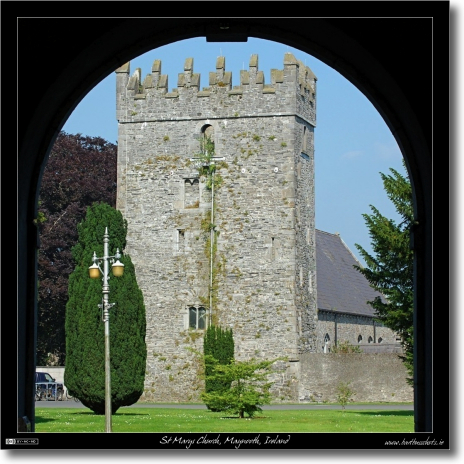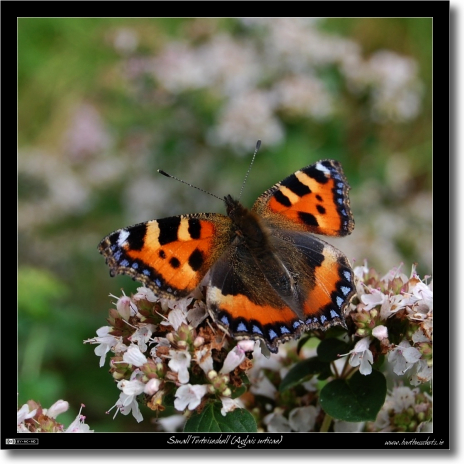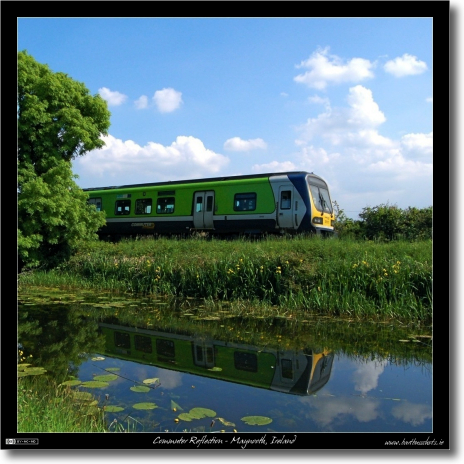Aug
31
Photo of the Week 28 – Hawthorn Blossoms
Filed Under Photography on August 31, 2008 | Leave a Comment
Each year in May Irish hedgerows get painted white by Hawthorn blossoms. Each flower is tiny, but a few million of them soon add up! This is a close-up shot of a small bunch of blossoms near the start of the season.
For those of you interested in such things here are some of the technical details of this shot:
- Camera: Nikon D40
- Lens: Nikon DX AFS 55-200mm
- Exposure: 1/1250 sec
- Focal Length: 200mm
- Focal Ratio: F8
- ISO: 400
- Camera Mode: Aperture Priority
- Exposure Compensation: -0.33
[tags]Maynooth, Kildare, Ireland, Hawthorn, flower, blossom, white, photography[/tags]
Aug
31
Indiana Jones and Kingdom of the God-Awful Film
Filed Under 42 (Life the Universe & Everything) on | Leave a Comment
I finally got around to watching the last (it better be the last) Indiana Jones film. It started well. The silhouette of Indie putting his hat on was fantastic, it felt like we were in for a true Indie film, another classic. Sure, Ford is old, but he’s clearly still got it! If only, the opening few minutes were the high point of the film, it was down hill from there. At first we were heading slowly down hill, but the speed soon picked up.
[tags]Indiana Jones, The Kingdom of the Crystal Skulls[/tags]
Aug
30
My Perl Image Processing Scripts
Filed Under My Projects, Computers & Tech, Software Development, Photography on August 30, 2008 | 6 Comments
Update (18 June 2012) – A more up-to-date version of these scripts can now be found here.
My Myers Briggs personality profile insists that I “prefer economy of effort”, you can probably translate that to “is a lazy sod”. Because of this I like automating repetitive tasks. It all started when I wanted a quick and easy way to prepare my images for posting to my website. I wanted them resized with my URL and the Creative Commons icon added in, and I wanted to be able to process a whole directory of images in one go. I started by playing around with the GD libs in PHP, but soon realised it would be quicker and easier to use Perl to shell out to the command line tools from Image Magick. At the time I wrote a post on my choice to do this which also contained the initial code. That code has been expanded and evolved since, and now includes functions for rendering nice (in my opinion) borders and titles on my better images. If you want to see examples checkout the Photo of the Week category on this blog..
[tags]Perl, Image Magick, script, programming, image processing[/tags]
Aug
29
The Periodic Table of Videos – Fun Chemistry
Filed Under Science & Astronomy on August 29, 2008 | 1 Comment
I was never very good at Chemistry. I cherry picked my way around it for the Junior Cert and didn’t take it for the Leaving Cert or as part of my science degree. I never really got beyond the three types of bond and the fact that electrons are in shells and that the amount of them on the outer shell is very important. I don’t think I ever considered Chemistry fun. However, I was really impressed by the work of the Chemistry department in the University of Nottingham when I stumbled across it last month. They have created a YouTube video about every single element in the periodic table! I’ve watched them all over the space of a few weeks (a few a day) and I learned a lot as well as being entertained. You get to see real chemists talking about the elements, as well as doing experiments with some (often involving explosions), and you get to see samples of most of them. Although I always knew what Gold and Silver looked like, I had no idea what Bismuth looked like! What’s also cook is that these videos are still being updated and expanded so you can watch the project grow.
You’ll find the periodic table of videos at www.periodicvideos.com. They also have a channel on YouTube where you can see all the videos and subscribe to their feed so you never miss an update!
Aug
27
Mobile Me – A Polished Turd?
Filed Under Computers & Tech on August 27, 2008 | 5 Comments
The problem with .Mac (the previous name for Mobile Me) was never the concept, nor was it what was promised, the problem was always the implementation. I expressed my views on .Mac back in January 2007 in a post entitled “.Mac – The Devil is in the Implementation”, and nothing has really changed since. I had high hopes that Mobile Me would finally give us the .Mac we’d always wanted. If all Mobile Me had been was a working version of .Mac without any new functionality it would have been great! However, since it’s launch Mobile Me has just been one disappointment after another. Things started badly when it took them days to get the system even remotely stable, got worse when they permanently lost thousands of people’s email, and didn’t improve at all when we found out Apple had lied to us about push.
[tags]Apple, Mobile Me, .Mac, iDisk, security[/tags]
Aug
26
A Quick & Dirty BibTex Cheat-Sheet
Filed Under Computers & Tech on August 26, 2008 | Leave a Comment
This is just a quick guide to getting BibTeX to work in a LaTeX document. This is not meant to be an introduction to BibTeX for someone who’s never heard of it, but rather a cheat-sheet for those of us who don’t use it quite often enough to remember the details without a little help.
First you need to create and manage your bibliography database (.bib file). You could do this by hand, but if you’re on OS X I’d highly recommend BibDesk. Much simpler.
Secondly, you insert citations in the document using the \cite{} command. Each entry in your bibliography database has a separate citation key, you use this key to insert a reference. For example, if my bibliography database contained a reference with a citation key ‘Busschots2008’ I’d insert a citation to that reference with the command:
\cite{Busschots2008}
Thirdly, you need to include your bibliography in your document. To do this you need to set a style for it, and then include it. If you’re not sure what style to use start with plain. Assuming your bibliography database is in a file called Sample.bib, you’d include it with the following code (notice that you don’t add .bib to the end of the file name):
\bibliographystyle{plain}
\bibliography{Sample}
Finally, to render the document you now need to run your document through both BibTex and LaTeX in the following order:
latexbibtexlatexlatex
Aug
24
Photo of the Week 27 – St. Mary’s Church
Filed Under Photography on August 24, 2008 | Leave a Comment
This shot shows the tower at the back of St. Mary’s protestant church in Maynooth as seen from the St. Patrick’s College/NUI Maynooth South Campus. In some ways this almost a cliché in Maynooth. Very few photographers pass through the arch outside Callan Hall without thinking “wow, this arch frames that church tower perfectly”. For that reason I can take no credit what-so-ever for the concept of this shot, just for the implementation. It’s amazing how many different shots you can get from the identical spot by changing your height above the ground and your focal length. I must have taken about 50 shots before choosing this one as my favourite.
For those of you interested in such things here are some of the technical details of this shot:
- Camera: Nikon D40
- Lens: Nikon DX AFS 18-55mm (D40 kit lens)
- Exposure: 1/160 sec
- Focal Length: 55mm
- Focal Ratio: F11
- ISO: 200
- Camera Mode: Aperture Priority
- Exposure Compensation: 0.0
[tags]Maynooth, Kildare, Ireland, NUIM, SPCM, church, tower, arch, photography[/tags]
Aug
17
Photo of the Week 26 – Small Tortoiseshell Butterfly
Filed Under Photography on August 17, 2008 | 1 Comment
Just because something is common, doesn’t mean it isn’t beautiful. After the Cabbage White the Small Tortoiseshell (Aglais urticae) is probably our most common butterfly, but I also think it’s one of our most beautiful. You can’t miss the lovely reds, but look closer and you’ll also see wonderful bright blue spots along the edges of the wings. These guys are strongly attracted to a lot of garden flowers so keep an eye out for them in your back yards! I snapped this one while it was feeding on some Thyme that was flowering.
For those of you interested in such things here are some of the technical details of this shot:
- Camera: Nikon D40
- Lens: Nikon DX AFS 18-55mm (D40 kit lens)
- Exposure: 1/160 sec
- Focal Length: 55mm
- Focal Ratio: F8
- ISO: 200
- Camera Mode: Auto
- Exposure Compensation: 0.0
[tags]butterfly, Small Tortoiseshell, Aglais urticae, Cavan, Ireland, photography[/tags]
Aug
13
Pondering University Fees
Filed Under Polemics & Politics on August 13, 2008 | Leave a Comment
Every few years this old chestnut comes up for debate again. With particularly suspicious timing the debate on third level fees is back on the agenda again. What I can say for sure is that the system we have now is fundamentally flawed, and that change is badly needed. Re-introducing fees could either make things better or worse, depending on how it was done. It is certainly no silver bullet to just make everything better.
Lets start by looking at the system we have now. The government decide how much money a student’s tuition is worth, and pay the Universities depending on their registration numbers. There is a registration fee which the student has to pay which theoretically covers administration costs. The amount paid per undergraduate student is the same in all universities as it’s set by the government. None of this applies to post-graduate courses where the universities each set their own fees.
This may have worked well for a while, but some serious cracks are now showing themselves. At the root of the problems is that fact that the government is not paying the universities enough per student, so they’ve had to start making up the balance in other ways. All they can do is jack up the registration fee, and the fees for postgraduates, so that’s what they’ve done.
The registration fee started off as insignificant, I believe it was about £40 when I was in first year, perhaps a little more but certainly less than £100. It is now well over €800! All students pay it, regardless of means or whether or not they are in receipt of a grant. Before “free” third-level education students on grants didn’t have to worry about fees, now they have a huge “registration fee” to pay which causes real problems for the poorer segments of society, erecting a barrier to entry that wasn’t there before. Pretty ironic really, considering the whole point was to lower the barrier to entry! This is bad for the country as a whole, which is totally dependent on our education system. Our only natural resource is our educated work force, and the government in it’s ever-shorter-sightedness is jeopardising that.
The same goes for postgraduate fees. When I started the fees were about £1,250 or there-abouts. Now they are well over €6,000. The reasons are the same, because the government are not paying enough per undergraduate student, the universities have to get their money in other ways, and in this case postgraduate students are it! Many postgraduate students get their fees paid by funding agencies, but for those who don’t get that very scarce money are totally shafted. Again, badly harming our knowledge economy.
So, under the current system the universities are underfunded, the poorest students are forced to pay an extortionary “registration fee”, and postgraduate studies are prohibitively expensive for all but the very best at sitting exams. The system is clearly broken! A very persuasive argument can be made that it is wrong for the government to pay for the education of the sons and daughters of millionaires. Hence the argument for bringing back fees, but only for the very rich.
If this is done right it could work, but if it’s done wrong it won’t make any difference at all, or even make things worse! Lets start by looking at how it could be done badly. Fees never left, they are just currently paid by the government (who set the price), rather than by the parents. As long as the government are paying fees for anyone, they are hardly likely to surrender that control. The problem is the fee is too low, so changing who pays it won’t help the universities at all, it will just save the government money. There would be no extra money in the actual universities and the registration fee and the postgraduate fees would continue to rise. This is what I expect our incompetent government to try to. It’s an attractive idea to a government in panic over public expenditure. In the short-term it lets them save public money and claim a victory in aid of helping save the economy. The long-term results will be disastrous, but in the short term it will look good, and governments are insanely short-term thinkers unfortunately.
So how could it be done right? I see three things being needed:
1) The abolition of the registration fee
2) A dramatic increase in the amount universities get per-student
3) only high income families should have to pay fees
4) government expenditure on third level education should not be reduced in real terms, the money coming from the rich families should be EXTRA money for third level, money which is desperately needs!
I believe it’s important for our country that we have a strong education system. An investment in education is an investment in the very future of our economy and our nation. It is not a waste of money, and, like healthcare, not an area that should suffer cutbacks or be neglected. What really matters is that universities are properly funded, and that they are easily accessible to every young person in our society, regardless of the wealth of their parents. I don’t care how that goal is achieved, I just care that it is achieved!
Aug
12
Photo of the Week 25 – Commuter Reflection
Filed Under Photography on August 12, 2008 | 3 Comments
I really don’t know why this is one of my very favourite images but it is. Maybe it’s the colours, maybe it’s the reflection. I do have a thing for reflections in photographs. This is just an ordinary Irish commuter train making it’s way from Maynooth in to Dublin along the Royal Canal on a summer evening at rush hour. For my fellow train spotters this is an Iarnród Éireann Class 29001 Diesel Multiple Unit.
For those of you interested in such things here are some of the technical details of the original shot:
- Camera: Nikon D40
- Lens: Nikon DX AFS 18-55mm (D40 kit lens)
- Exposure: 1/1000 sec
- Focal Length: 18mm
- Focal Ratio: F10
- ISO: 800
- Camera Mode: Aperture Priority
- Exposure Compensation: -0.67
[tags]train, canal, Royal Canal, Maynooth, Kidlare, Ireland, photography[/tags]










